| INTRO TO ANALOG SYNTHESIZERS | | | Most soft synths - and many hardware synths, too, for that matter - use analogue synthesis to generate their sounds. In fact, the digital synthesis methods used by many digital synthesizers are based on the principles of analogue synthesis, and a basic grounding in analogue will help you understand how most synths work. It's not difficult. Well, okay, we'd be the first to admit that some of it can get pretty hairy, but then so can crossing the road. In this feature we'll explain the basics which will give you enough information to tweak the sounds in an analogue synthesizer and create new ones from scratch. A very good way to understand what the controls we're going to talk about do, is to load a soft synth and tweak the parameters as we describe them. The combination of reading with practical examples will make the process much easier to understand. So fire up that digital noise machine and let's get synthin'! The three stages
Synthesis is about the creation of sound, and whichever way that sound is put together, it will have three main elements - pitch, tone (or timbre) and loudness.
Analogue synthesis is essentially a three-stage process:
Tone generation > tone shaping > volume shaping
The pitch side of the three elements is created when the sound is played from a keyboard or via a sequencer when the system receives a note message telling it what pitch to play.
In analogue synthesis, raw sounds are generated with an oscillator, tonal shaping is performed with a filter, and volume is controlled by an envelope generator. We'll look at each of the stages in turn and see how they fit into the big picture.
An oscillator is a device for generating waveforms. In older analogue synths they were regular or cyclic waveforms such as sine, triangle, square and sawtooth, but computer-based oscillators can generate all sorts of weird and wonderful wave shapes.
You can hear the differences between waveforms because they each have a distinct sound which is determined by their harmonic content. Each wave is based on a fundamental frequency which is the actual pitch we hear. A tone which consists only of the fundamental is a sine wave and sounds very pure, almost flute-like, because it has no harmonics.
Harmonics, sometimes called partials, are frequencies which are higher than the fundamental and which give a sound its tonal colour. The relationship between the fundamental and its harmonics can be simple or very complex. A square wave, for example, contains only odd-numbered harmonics, each with a volume level equivalent to its own number in the series. The third harmonic is a third the volume of the fundamental, the seventh is a seventh the volume and so on. Square waves have a hollow, clarinet-like sound.
A sawtooth or ramp wave contains all the harmonics, again at their reciprocal volume level as in the square wave described above. This type of wave generates a very rich, brassy sound. Triangle waves sound a little like sine waves but have a few harmonics. Pulse waves are also common and sound nasal, like an oboe. There are also noise generators which contain a full range of frequencies and which sound like... noise!
Most oscillators have a pitch control which lets you set the basic pitch of the output. It usually works like an octave up/down control. The note information from a keyboard or sequencer is added to the oscillator's basic pitch to create notes. Harmonics, sometimes called partials, are frequencies which are higher than the fundamental and which give a sound its tonal color. | Six Waves
...and the differences between them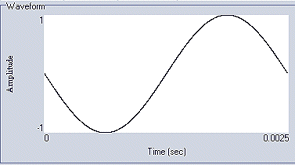
The sine wave produces a simple pure tone with no harmonics.

The triangle wave produces a tone similar to the sine, but a little less 'round' as it contains a few harmonics.
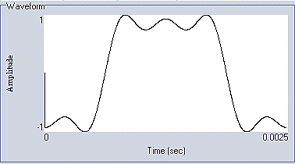
The square wave is made up from odd numbered harmonics and sounds hollow. 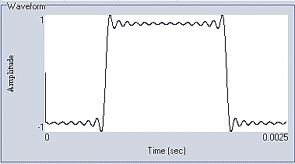
As more odd harmonics are added, the square wave becomes increasingly more square in shape.

The sawtooth ramp contains all harmonics and sounds rich and brassy.

Noise is a combination of many frequencies and sounds, er, noisy.
|
Fab filters
The waveforms are our raw material. We obviously don't want every sound we produce to sound like a square wave or a sawtooth wave, so we use a filter to change it.
If you've dabbled with digital audio, you'll be familiar with EQ effects. These are filters designed to cut or boost a specific frequency band. A filter in a synth does much the same thing. The two main controls in a filter are the cutoff frequency and resonance (sometimes known as Q and, less often, emphasis). The cutoff frequency determines the point at which the filter starts filtering.
There are several types of filter. Far and away the most common is the low pass filter. As its name suggests, this passes the lower frequencies while filtering out the higher ones. The point at which it starts filtering is the cutoff point determined by the cutoff control. Its general result is to reduce the high frequency content, making the sound more bassy.The high pass filter works the other way around and filters - or attenuates, if you're a techy synthesist type - the low frequencies. Its general result is to remove the lower frequencies, thereby making the sound thinner.
There's also the band pass filter which passes a band of central frequencies while filtering those above and below it, and the band reject or notch filter which filters the frequencies in a central band, leaving those above and below.
If the cutoff frequency is set extremely low in a low pass filter, the filter won't pass any sound at all. The same if it is set high in a high pass filter. Think about that for a moment and you'll see it makes sense.
The resonance control is interesting. It boosts the amplitude (that's volume to us normal folks) of the frequencies around the cutoff point. As the resonance is increased, the boosted band becomes narrower. Resonance, particularly if it can be varied in real-time during the production of a sound, can create all sorts of interesting wah effects.
Notice that all these filters remove harmonics from the main waveform. Some forms of synthesis construct a sound from the ground up by adding waves together (this is known, naturally enough, as additive synthesis), but analogue synthesis starts with a sound rich in harmonics and chips bits off. It is, therefore, sometimes called subtractive synthesis. 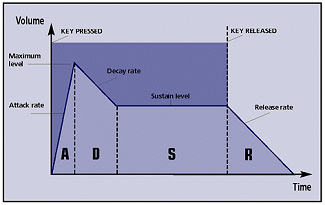
| Body shaping
We now have a tone which has been filtered to produce a different sound to the original waveform. The next stage is to shape its loudness contour, or envelope as they say in Blyth. This determines the volume of the sound during its production. It can vary considerably between sounds and plays an essential part in giving a sound its own individual character.When you hit a woodblock, for example, its volume immediately rises to full and then just as quickly dies away. Press a key on an organ and the volume rises to full volume, stays there as long as you hold down the key and then drops quickly when you release it. On a piano the sound starts as soon as you press a key but then dies away gradually, even with the key held down. String sounds take a little longer to reach full volume (okay, we're talking fractions of a second, but our ears can tell the difference) and a short while to die away. All these are examples of volume envelopes, and although some may appear quite complex, we can duplicate most natural envelopes quite accurately using a four-stage envelope generator. The four stages are called attack, decay, sustain and release, and envelope generators are often called ADSR generators after the four phases. Here's what they do: - Attack: This is the length of time required for the sound to reach its initial maximum volume. Obviously it will be very short for a percussive sound.
- Decay: This is what happens immediately after a sound hits its maximum volume level in the attack phase. It's the time taken for the volume to reach a second volume level known as the sustain level.
- Sustain: This is not a length of time but a volume level at which the sound sustains after the decay phase. In most sounds is it lower than the attack volume, but it could be the same or even higher. Usually, it's the volume at which a sound plays while a key is being held down. This phase can, theoretically, last forever - or at least until you get tired of holding down the key.
- Release: This is the final phase, again measured in time, and is the time it takes the volume to reduce to zero.
Just to confuse matters - but only slightly - a sound does not have to have all four phases. A woodblock, for example only has an attack phase and a decay phase. An organ has an attack phase, a sustain phase and a release phase but no decay phase. As well as ADSR generators, some synths, such as SynC Modular, have an AD (Attack/Decay) generator.
ADSR: The four phases of an ADSR envelope. Notice how they relate to a key being pressed. | Modular Synthesis:
They're back, and this time they're soft!
Back in the 70s and early 80s, modular synthesizers were very much in vogue. They included Roland's System 700 and the smaller 100M system, and there were several Moog Modular systems. The common perception of a modular synth is a wall-filling bank of synth modules with spaghetti wires plugged into every orifice - and that is exactly what these instruments look like.
What makes a modular synth modular is that it consists of individual modules - easy, innit? Unlike performance or hardwired synths (as virtually all keyboard-based synths are today), the modules are not connected internally and need to be physically linked in order to make a sound. Connections are usually done with jack plug cables, and a sound-producing configuration is known as a patch. Hence the term patch is still used today to mean a 'sound', and the linking cables are called patch chords.
It's difficult to use a modular synth unless you know exactly what you're doing, because the modules must be connected in specific ways to produce a sound. For example, if the keyboard's gate output (which basically triggers a note) is not connected to the envelope generator, and that's not connected to the amplifier, you won't hear a thing. With a hardwired synth, everything is pre-connected so there is usually always some sound at the output, making it easier to change the sound by twiddling a few controls.
| 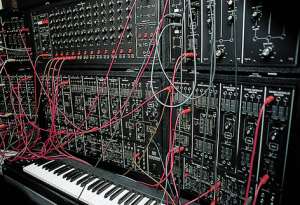 It's modular and it synthesizes sound. Its a modular synthesizer! It's modular and it synthesizes sound. Its a modular synthesizer!
Many soft synths are modular - Native Instruments' Generator, Audio Architect, and the SynC Modular synth on this month's CD are but three examples. There are also a few modern hardware module synths in production, but most of those are very expensive. So in this case, as in so many others, soft is definitely cheaper. |
Building blocks
Using just these three building blocks - oscillator, filter and envelope generator - it's possible to create a huge range of sounds, both natural-sounding and artificial. In many synths, including Atom, the modules are already connected (or hardwired, to use the correct terminology), which means you only have to fiddle with the modules' parameters in order to create sounds. In other synths, such as SynC Modular, they're not, which means they have to be connected using virtual patch chords before you get any sound at all.Obviously, synths of the hardwired variety are easier to use, but modular synths are much more flexible and capable of producing a greater range of sounds. You will need to read the instructions to learn exactly how to connect the modules, but essentially, the bits go together as follows, in modular as well as hardwired synths... The oscillator starts the ball rolling by generating a waveform. This is fed into a filter which changes its tone, and this is fed into the output amplifier. The volume the amplifier produces is controlled by the envelope generator. That set-up is essentially all you need to create a simple analogue synthesizer. But we don't just want to give you that! Most analogue synths have several oscillators, filters and envelope generators, plus many modules of other sorts to boot. But no matter how many modules you add or how you patch them together, the basic signal path stays the same: Oscillator > filter > amplifier. Let's look at a couple of more advanced configurations. Pushing the envelope
If we use an envelope generator to control the amplitude, can we also use it to control a different module? Yes, we certainly can. Let's take a simple woodblock-type envelope which goes straight up and comes straight down again. What would happen if we plugged this into a filter so it controlled the cutoff frequency? Yes, the cutoff frequency would follow the same pattern. If the cutoff frequency had been set to a mid point, for example, the envelope would raise it on the way up and lower it on the way down creating a filter sweep effect. The filter would open as the sound increased in volume and close as it decreased in volume making the sound brighter on the way up and then filtering out the harmonics on the way down. Hmm, getting interesting, eh? What if we had two envelope generators - one to control the amplitude and the other to control the filter? We'd have independent control over them both. Most synths, including Atom, have at least two envelopes which can be used for this very purpose. Here's another thought: could it be used to control pitch? Yes indeedy! Plug it into the oscillator and the pitch will shoot up and then drop down, creating a sort of whistle effect. These are very simple examples which you will be able to create with any modular synthesizer. Hardwired synths may not be as flexible, and although most will allow you to route an envelope to the filter, not all will allow you to route it to the oscillator, for example. Using just these three building blocks - oscillator, filter and envelope generator - it's possible to create a huge range of sounds, both natural-sounding and artificial. | Four Filters...
And we 'aint talking coffee...
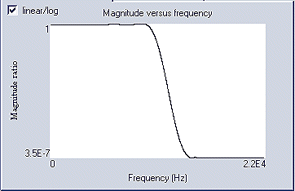
A Low Pass filter passes the low frequencies and attenuates the ones above the cutoff point.
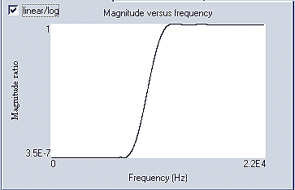
A high pass filter passes the high frequencies and attenuates the ones below the cutoff point.
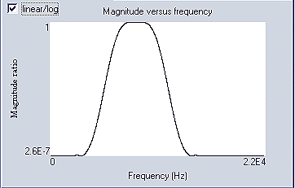
A band pass filter passes the high frequencies on either side of the cutoff point and attenuates the ones further away.
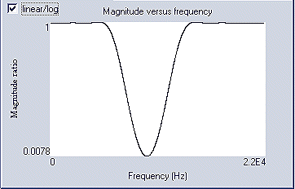
The band reject or notch filter filters out the frequencies around the cutoff point and passes the ones further away |
How low can you go?
Let's look at one more module. This is probably the most common additional module to be found in an analogue synth - the LFO. No, this is not a Low Flying Object but a Low Frequency Oscillator. As its name suggests, it's an oscillator that vibrates at a frequency way below our range of hearing. It could be set to oscillate a few times each second or even once a minute.The choice of waveforms in an LFO are often the same as in an oscillator. The two main controls in an LFO are depth and frequency. The frequency determines how quickly the LFO runs and the depth is the amplitude of the wave. LFOs are most often applied to the oscillator to modulate the pitch. Using a sine wave, for example, the pitch will rise and fall regularly up and down. With a frequency setting of around seven cycles per second, the result will be a musical vibrato. Crank the depth up, however, and it will turn into a siren! If a square wave was used instead of a sine wave, the pitch would oscillate between two pitches, rather like a trill. Select a noise waveform and pitches will be generated at random. The depth setting here would determine the upper and lower limits of the pitch range. If you're wondering whether the LFO could be applied to other modules, you're way ahead of us. Plug a gently-oscillating sine wave into the amplifier and the result will be tremolo. Tremolo is to volume what vibrato is to pitch. | 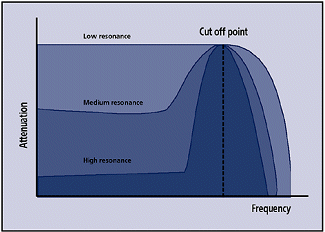
Increacing the resonance boosts the volume of the frequencies around the cutoff point. The higher the resonance, the more prominent those frequencies become.
Plug the LFO into the filter and you'll get a variety of filter sweep effects. That's our quick look at the basics of analogue synthesis. There are lots of other synthesis modules for both hardware and software synths and most of them can modulate each other - it's all rather incestuous! The more complex and involved the modulations, the more complex and sonically interesting the resulting audio output will be. But the basic audio routing from oscillator to filter to amplifier remains the same.
There - you've just mastered the essentials! |
 The rise, fall and rise again of the analogue Synth: The rise, fall and rise again of the analogue Synth:
Into the digital and beyond...
Analogue synthesizers use analogue circuitry to generate their sounds. It may seem like a quaint idea in this age of digital chips, but that's the way it was in the dark ages. Analogue circuitry is not as stable as digital circuitry and synths often went out of tune, although this often created a 'warm' effect much beloved by analogue synth enthusiasts.
When digital synths arrived there was much rejoicing. The circuits were rock solid so tuning did not drift and manufacturers could put more features on a chip than were possible with analogue designs. However, this soon lead to a proliferation of over-complex parameters, multi-level menus, small LCD displays, and buttons which had several functions. For this reason, many users never even attempted to tweak the sounds or create a new ones.
Digital synths also lacked hands-on controls. The filter, for example, couldn't be adjusted on the fly because it was hidden behind a menu. So manufacturers brought out synths with twiddly bits, such as Roland's JD-800.
The new music and the new musicians of the 90s demanded more hands-on control, not to mention fat, sweepy noises, so the old analogue synths of yesteryear were resurrected and exchanged hands for unfeasibly large sums.
As computers grew in power, it didn't long for a few astute programmers to realise that an analogue synth could be programmed in software. So that's what they did and a whole new genre of music software was born. Even though soft synths look and work like analogue synths, they are actually digital (software's digital, see). But being software, it's easy to add extra modules and features, and soft synths, being endlessly redesignable, have the potential for even more mind-blowing complexity than digital synths. Now that's progress!
|
|
| |
| |
